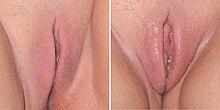Vaginal lubrication

Right: Vaginal lubrication sometimes becomes visible after sexual arousal.
Vaginal lubrication is a naturally produced fluid that lubricates the
Vaginal discharge
Composition
Vaginal fluid is slightly acidic and can become more acidic with certain sexually transmitted infections. The normal pH of vaginal fluid is between 3.8 and 4.5, contrasting with male semen which is typically between 7.2 and 7.8 (neutral pH is 7.0).[1]
During arousal, vaginal lubrication, also sometimes called "arousal fluid", is produced. This is clear, thin, and slippery. It typically only lasts up to an hour.[2][3]
Production
The human
Vaginal dryness
Insufficient lubrication or vaginal dryness can cause
Certain medications, including some over-the-counter
In seemingly rare cases, selective serotonin reuptake inhibitors (SSRIs) have been reported to cause a long-lasting iatrogenic disorder known as post-SSRI sexual dysfunction, the symptoms of which include reduced vaginal lubrication in females.
Older women produce less vaginal lubrication and reduced estrogen levels may be associated with increased vaginal dryness.[5]
Artificial lubricants
When a woman is experiencing vaginal dryness before sexual activity, sexual intercourse may be uncomfortable or painful for her. A personal lubricant can be applied to the vaginal opening, the penis (or other penetrating object such as fingers or a dildo), or both, to augment the naturally produced lubrication and prevent or reduce the discomfort or pain. More rarely, a vaginal suppository may be inserted prior to intercourse.
Dry sex
Some people practice dry sex, which involves the removal of vaginal lubrication in some way.[6] The rationale for the practice seems to be for cleansing purposes and to enhance the sexual pleasure of the penetrating partner.[7] However, besides making sexual intercourse painful for the female,[8] the practice is believed to increase the risk of transmitting sexually transmitted infections for both partners,[8] such as HIV, whose risk of transmission is increased by lacerations in the vaginal tissue resulting from the lack of lubrication.[9]
See also
- Female ejaculation
- G-spot
- Pre-ejaculate
- Skene's gland
- Spinnbarkeit, the stretchiness of cervical mucus associated with ovulation; one property of this secretion is to lubricate the vagina
- Toxic shock syndrome, linked to the use of tampons.
- Urethral sponge
- Vabbing
- WAP (song)
References
- ^ "Semen analysis". Archived from the original on October 17, 2007. Retrieved 2007-10-18.
- ^ "Cervical Mucus Monitoring | Time to Conceive". www.med.unc.edu. Retrieved 2021-12-22.
- ^ "Getting wet: cervical fluid vs. arousal fluid vs. discharge". helloclue.com. Retrieved 2021-12-22.
- .
- ^ "SEXUALITY IN OLDER WOMEN AND THEIR PARTNERS: AGE-RELATED FACTORS THAT IMPACT SEXUAL FUNCTIONING". sexualityandu.ca. 2008. Retrieved 10 August 2010.
- ^ International Family Planning Perspectives, Volume 24, Number 2, June 1998, Vaginal Drying Agents and HIV Transmission by Karen E. Kun.
- JSTOR 3775349.
- ^ a b "Concern voiced over "dry sex" practices in South Africa". www.cirp.org.
- ^ ""Dry sex" worsens AIDS numbers in southern Africa". 10 December 1999.
External links
- Vaginal dryness – Mayo Clinic
